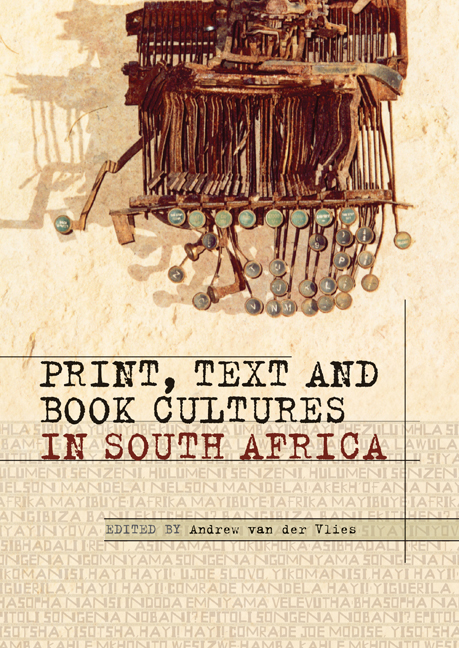Book contents
- Frontmatter
- Contents
- Acknowledgements
- Abbreviations and acronyms
- 1 Introductory
- 2 Print Cultures and Colonial Public Spheres
- 3 Local/Global: South African Writing and Global Imaginaries
- 4 Three Ways of Looking at Coetzee
- 5 Questions of the Archive and the Uses of Books
- 6 Orature, Image, Text
- 7 Ideological Exigencies and the Fates of Books
- 8 New Directions
- 8.1 The Rise of the Surface: Emerging Questions for Reading and Criticism in South Africa
- 8.2 Sailing a Smaller Ship: Publishing Art Books in South Africa
- 8.3 The University as Publisher: Towards a History of South African University Presses
- Contributors
- Index
8.2 Sailing a Smaller Ship: Publishing Art Books in South Africa
from 8 - New Directions
Published online by Cambridge University Press: 21 April 2018
- Frontmatter
- Contents
- Acknowledgements
- Abbreviations and acronyms
- 1 Introductory
- 2 Print Cultures and Colonial Public Spheres
- 3 Local/Global: South African Writing and Global Imaginaries
- 4 Three Ways of Looking at Coetzee
- 5 Questions of the Archive and the Uses of Books
- 6 Orature, Image, Text
- 7 Ideological Exigencies and the Fates of Books
- 8 New Directions
- 8.1 The Rise of the Surface: Emerging Questions for Reading and Criticism in South Africa
- 8.2 Sailing a Smaller Ship: Publishing Art Books in South Africa
- 8.3 The University as Publisher: Towards a History of South African University Presses
- Contributors
- Index
Summary
INTRODUCTION: STORM AT SEA
In times of international economic downturn, art books may seem a curious indulgence. They are costly to produce and, despite enormous strides in book technology (signalled by the “e-book” logo that now appears on the back cover of printed books), they resist conversion to Kindle and other digital platforms. Conversations with local and international book distributors— those mercurial figures who flit between publishers and bookstore managers, fingers to the breeze to anticipate storms and doldrums—are not encouraging. Reports are of the big chain retail stores trying to stanch a bleeding wound, serious declines in revenue and the threat of store closures (the scene is the same in Johannesburg and New York). “Heavy-buying” customers are no longer coming through the doors, but are purchasing online—real books or e-books by the dozen, at a fraction of the price of the printed versions (these are the kinds of buyers that buy several books at a time and return regularly; they are the bread and butter of the retail trade). In the 1980s and 1990s megastores cannibalised small independent bookstores, a trend that had a severe impact on the sale of specialised art books. The megastores chose picture books that were cheaper, less scholarly and more appealing to a mass audience than the finely produced books that the smaller stores were good at selling. But now, it seems, the monster is ailing.
The faltering of the big retail outlets (Exclusive Books in South Africa, Waterstones in the United Kingdom and Barnes & Noble in the US, for example) is not due, however, to a decline either in publishing or in the numbers of people reading books. Rather, their problems are a result of the
massive changes—spurred on by the combined effects of technology and economic recession—that publishing is undergoing globally. Readers there are aplenty (and, indeed, some analysts suggest that since we belong more and more to a visual culture, illustrated books have more readers than ever) and there are books to satisfy the demand. What has changed is how we read.
- Type
- Chapter
- Information
- Print, Text and Book Cultures in South Africa , pp. 422 - 436Publisher: Wits University PressPrint publication year: 2012



